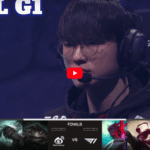Marvel Rivals Esports Potential Analysis: In-Depth Review & Outlook
Updated On: November 29, 2025 by Aaron Connolly
State of Marvel Rivals Esports

Marvel Rivals has built a solid competitive foundation just months after its December 2024 launch. Major tournaments pull in hundreds of thousands of viewers, and big names like 100 Thieves and Fnatic are already investing in teams.
Emergence of the Competitive Scene
Marvel Rivals jumped into esports right out of the gate. NetEase crafted the hero shooter with competition in mind from the very beginning.
Over 10 million players jumped in within the first 72 hours. This massive turnout convinced organizers to kick off big tournaments almost immediately.
Key organizations moved fast:
- 100 Thieves (North America champs)
- Fnatic
- Sentinels
- OG Esports (now OG Seed)
- DarkZero
The scene grew from small exhibitions to million-pound prize pools in less than half a year. Teams now have dedicated coaches and even training facilities.
Marvel Rivals locked in major sponsorships right away. The Marvel name pulled in non-endemic sponsors who usually steer clear of new esports titles.
Viewership Trends and Popularity
Marvel Rivals viewership keeps climbing across several platforms. Still, Twitch dominates as the main spot for competitive matches.
Peak viewership numbers:
- Marvel Rivals Ignite Stage One: 355,000 peak viewers
- Twitch Rivals Showdown: 176,000 peak viewers
- Marvel Rivals Invitational NA #2: 71,000 peak viewers
YouTube numbers swing a lot. The Season 1 Grand Finals pulled in 227,000 views, but Season 2 dropped to just 59,000.
The 1.9 million hours watched during the Marvel Rivals Invitational show that viewers stick around for entire tournaments, not just a few minutes.
Streamers like xQc and shroud gave early viewership a big boost. When they joined the Twitch Rivals event, mainstream gamers started paying attention to Marvel Rivals esports.
Key Esports Events
The tournament calendar revolves around three main types of competitions. Each caters to different audiences and skill levels.
Marvel Rivals Ignite sits at the top. The $3+ million prize pool covers multiple regions, and the Americas Stage One Playoffs became the most-watched Marvel Rivals event so far.
Marvel Rivals Championships happen seasonally with smaller prize pools. These keep the competitive scene moving between the big events. Season 0 and 1 did well on YouTube, but Season 2 viewership slid.
Marvel Rivals Invitational series brings in regional battles. The North America #2 event had a £78,500 prize pool and ran for 42 hours straight.
Twitch Rivals events put content creators in the spotlight instead of pro teams. The January 2025 showdown had a £148,200 prize pool and saw the highest viewer engagement.
Comparison to Other Hero Shooters
Marvel Rivals has to compete with Overwatch 2, Valorant, and Counter-Strike 2. All three have years of competitive history.
Overwatch 2 lost steam after the original Overwatch League’s struggles. Marvel Rivals seems to have learned from those mistakes, especially around tournament formats.
Valorant took almost two years to break 200,000 peak viewers regularly. Marvel Rivals hit similar numbers in just a few months.
The hero shooter genre lets fans bet on matches in familiar ways. Stuff like winning teams, individual stats, and objective captures all carry over from Overwatch.
Marvel Rivals’ seasonal championship model copies Valorant’s structure instead of Overwatch’s franchise approach. This keeps costs down for organizations but still protects competitive integrity.
Counter-Strike 2 and Valorant post higher peaks, but Marvel Rivals’ early growth has outpaced both in their first years.
Foundations of Esports Success
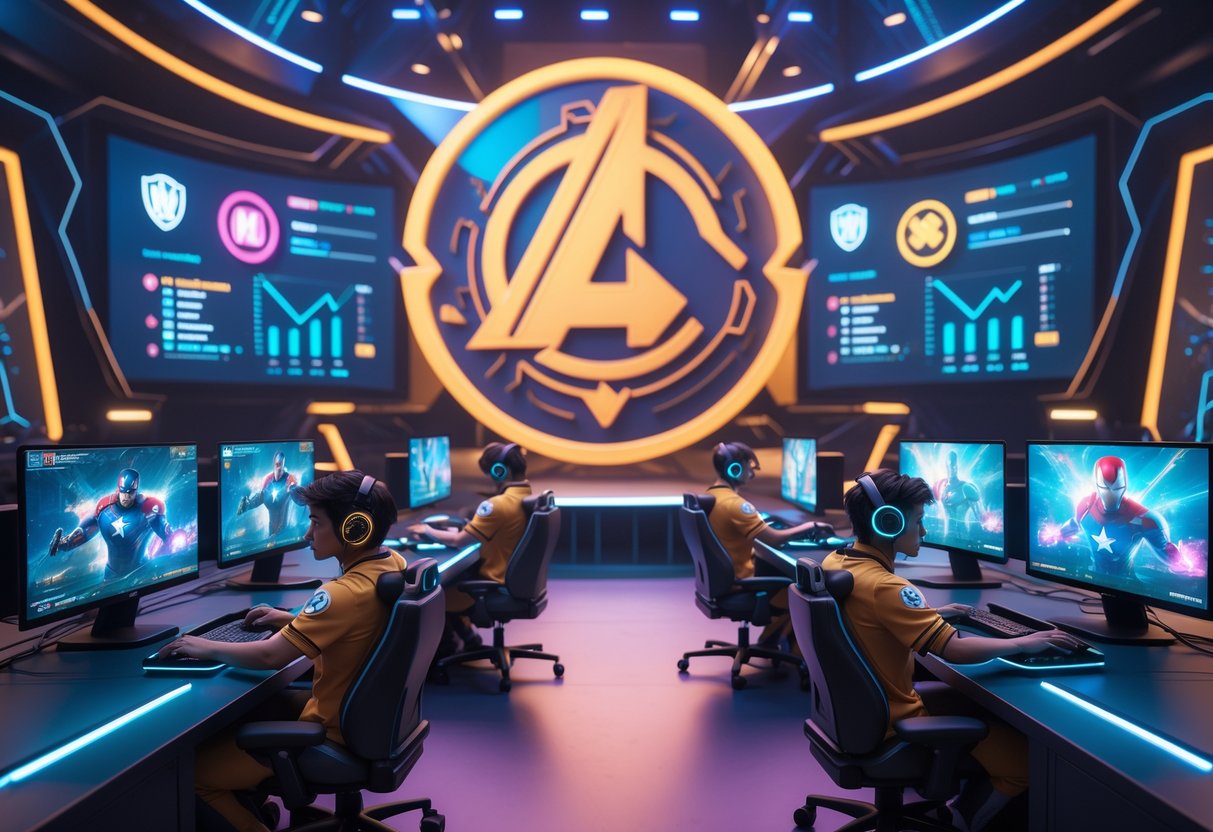
Marvel Rivals stands on a strong foundation thanks to NetEase’s long-term investment, major org support, and a structured tournament system. These three pillars give the scene real staying power.
Developer Support from NetEase
NetEase kicked off the competitive scene barely a week after Marvel Rivals launched in December 2024. They rolled out the Marvel Rivals Championship Season 0 with $14,500 in prize money per region.
This quick move showed they meant business. Most games wait months before testing the esports waters.
NetEase promised to invest in Marvel Rivals esports for over a decade. That kind of commitment reassures teams and players who worry about the scene fizzling out after the hype fades.
The developer runs multiple tournament series at once:
- Marvel Rivals Championship (main series)
- War of the Realms (regional events)
- Marvel Rivals Invitational series
Regular content updates keep the meta from getting stale. New heroes and balance tweaks shake things up and stop the game from feeling old.
NetEase’s background with other competitive games means they know the ropes. They handle prize distribution, broadcasts, and player support with experience.
Community and Organizational Investment
Big esports orgs jumped into Marvel Rivals early. European powerhouses OG and Fnatic signed teams right away, showing faith in the game’s future.
North American teams didn’t wait around either. 100 Thieves, Sentinels, and FlyQuest all joined within a few months.
International teams include:
- Virtus.pro (Armenia/Russia)
- Twisted Minds (Saudi Arabia)
- EHOME and LGD Gaming (China)
Streamer Michael “Shroud” Grzesiek made headlines by signing his Shroud-X roster, bringing loads of attention to the scene.
North American tournaments draw the biggest crowds so far. That matters since NA is a goldmine for sponsors and brands.
Popular streamers like TimTheTatman, xQc, and Ninja play Marvel Rivals regularly. Their audiences create a huge pool of potential esports fans.
Co-streaming with these creators could send viewership through the roof. Valorant’s success with this model backs that up.
Tournament Infrastructure
Marvel Rivals’ tournament system borrows from tried-and-true esports formats. Regional competitions feed into bigger international events, giving players a real path to the top.
Current prize pools are modest but reasonable. The $14,500 regional championships offer meaningful rewards without breaking the bank.
Pure competitive events haven’t cracked 30,000 concurrent viewers yet. But tournaments with popular streamers do much better.
Official Twitch and YouTube streams peaked between 12,000 and 23,000 viewers. Those numbers aren’t massive, but they show real interest.
Tournament formats stick to team-based play. Six-versus-six matches offer enough depth for strategy but keep things watchable.
Broadcasting has the same problems Overwatch had early on. The action moves fast, and multiple fights break out at once, which makes it tough for viewers to keep up.
Player POV streams help a lot. Watching from a player’s perspective makes the chaos easier to follow.
The current infrastructure supports regional play well. The next step? Scaling up to major international events with bigger prize pools and slicker broadcasts.
Distinctive Gameplay and Mechanics
Marvel Rivals shakes up the shooter genre with its superhero-driven gameplay, team roles, and destructible environments. These features bring a level of strategy that sets it apart from other hero shooters.
Hero Shooter Elements
Marvel Rivals sticks to the classic hero shooter formula, but with Marvel’s legendary cast. Every hero comes packed with unique abilities that fit their comic book powers.
Iron Man zips around with repulsor blasts and flight. His ultimate can wipe out clustered enemies. Thor swings his hammer for melee and ranged attacks and calls down lightning.
Spider-Man brings verticality with web-slinging. He swings between buildings and drops in on unsuspecting foes. Doctor Strange opens portals so teammates can zip across the map.
The game launched with over 20 heroes. Each one stands out, and players can swap heroes between rounds to counter the enemy.
Ultimate moves feel like scenes straight out of Marvel movies. Thor’s Bifrost devastates areas, and Scarlet Witch bends reality. These abilities can flip a fight if timed right.
Role Variety and Team Composition
Teams field five players across three roles: Damage, Tank, and Support. This setup forces teams to think about strategy, not just individual skill.
Damage heroes like Iron Man and Spider-Man focus on taking out enemies. They hit hard but can’t take much punishment. Most teams run two or three damage heroes.
Tank heroes such as Hulk soak up damage and protect allies. With high health and aggro-drawing skills, they’re essential for most teams.
Support heroes keep everyone alive and provide utility. Good support play often decides close matches.
Team composition matters more than raw skill. Well-coordinated teams with balanced lineups usually beat groups of solo stars. Pros spend hours drilling different comps for each map.
Destructible Environments
Marvel Rivals’ maps break apart as matches unfold. Players can smash walls, opening up new lines of sight or sneaky flanking routes.
Hulk, for example, can bust through barriers others can’t. Teams running tanks get unique strategic options. Environmental destruction means players have to rethink their positioning constantly.
Dynamic objectives shift around as the environment changes. Teams fight for new areas as walls fall and paths open up. This keeps matches fresh and unpredictable.
Maps feel alive, with explosions taking down buildings and new routes popping up mid-match. Players can’t just memorize layouts and coast.
Destruction changes cover and sightlines. Lose a wall, and suddenly your defensive setup is gone. Teams have to adapt on the fly, which keeps matches fast-paced.
Marvel Brand Appeal in the Esports Landscape
Marvel’s global fame gives Marvel Rivals a big edge in pulling in both gamers and mainstream audiences. The superhero theme brings in fans who might never have bothered with esports otherwise.
Attracting a Wider Audience
The Marvel universe gives Marvel Rivals instant name recognition. Casual fans spot Iron Man or Spider-Man and don’t need a lore lesson to get interested.
Marvel Rivals breaks down traditional esports barriers:
- No confusing character names or abilities
- Heroes everyone knows from movies and comics
- Teams look visually distinct at a glance
We’ve seen this work before. Fortnite’s Marvel events always spike viewership.
The superhero vibe appeals to parents and older fans who grew up with Marvel comics. That opens the door to family viewing—something you rarely see with games like Counter-Strike or League of Legends.
Gaming journalist Aaron Connolly put it well: “Marvel Rivals doesn’t need to explain why Wolverine has claws or what Thor’s hammer does. That familiarity removes the biggest hurdle for new esports viewers.”
Nostalgia and Fan Engagement
Marvel’s long history builds emotional connections that most game franchises just can’t match. Fans bring their loyalty to the characters, not just the gameplay.
Generational appeal covers everyone:
- Gen Z: grew up on MCU films
- Millennials: remember 90s cartoons and early movies
- Gen X: read the original comics
Tournament broadcasts can lean into this nostalgia with character-driven storylines. Instead of just “Team A vs Team B,” you get “Can the X-Men comp beat the Avengers?”
The Marvel brand also opens up cross-promotion opportunities with Disney’s other properties. Tournament promos can go out on Marvel’s massive social channels, reaching way beyond the usual gaming crowd.
Heads up: Leaning too hard on brand recognition without solid gameplay could backfire. Marvel Rivals needs to keep things balanced and competitive if it wants to stay relevant after the novelty wears off.
Establishment of the Competitive Ecosystem
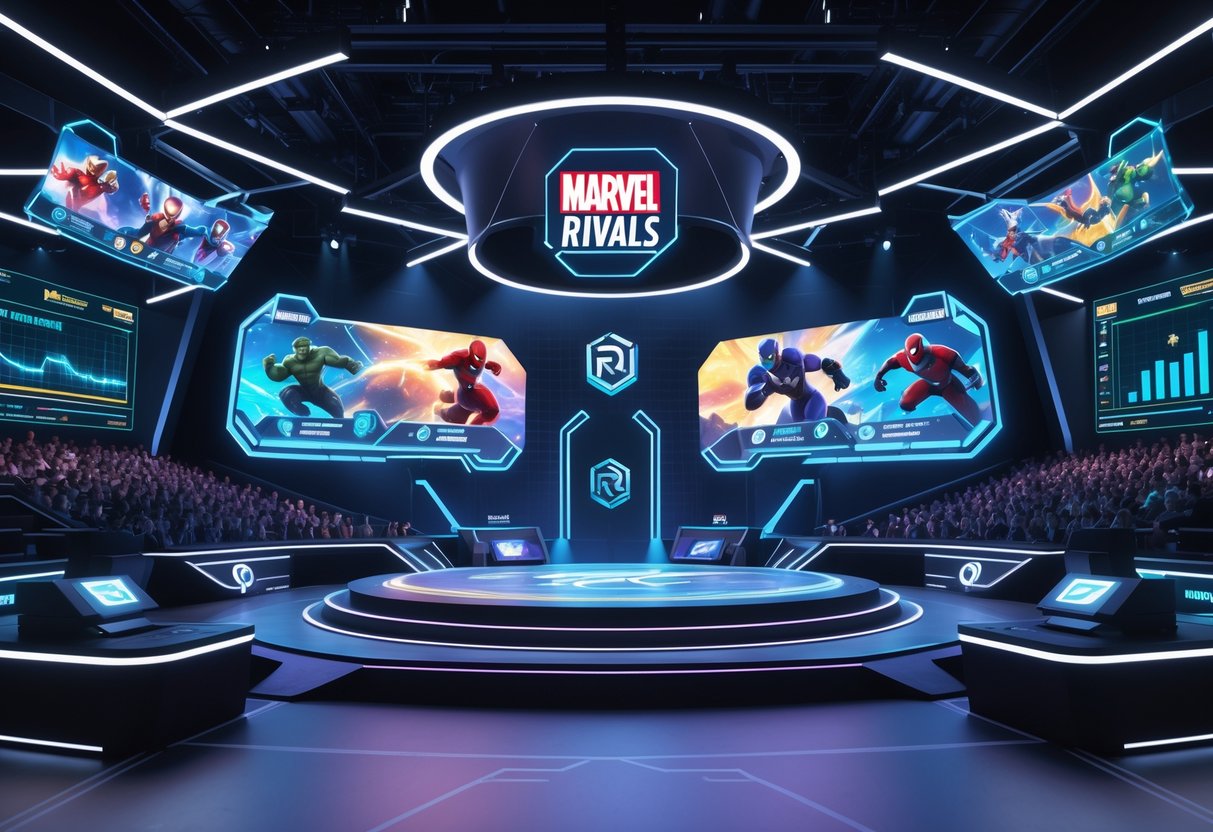
NetEase laid the groundwork for Marvel Rivals’ competitive scene with structured tournaments and early buy-in from big esports orgs. The Marvel Rivals Championship Season 0 kicked off just weeks after launch, and top-tier teams like 100 Thieves and Sentinels already jumped in with resources.
Regional and International Tournaments
Marvel Rivals’ competitive journey started with Championship Season 0 in December 2024. NetEase put up £11,500 prize pools across regional events. Sure, those aren’t huge by esports standards, but the events set up a solid base.
The Marvel Rivals Invitational series quickly became the main tournament track. North American events pull the biggest crowds so far, and the second invitational looks like it’ll be the most-watched yet.
Shroud co-casts major events, bringing in his massive following. This move feels a lot like Valorant’s co-streaming playbook, where creators often outdraw official streams.
Regional differences are already showing up. North America leads in viewership, which definitely matters for sponsors. The gap isn’t massive, but it’s big enough that orgs are starting to focus their investments there.
Most official tournaments hit around 12,000-23,000 concurrent viewers. Events without big streamers rarely break 30,000, so the scene still leans heavily on creator hype.
Growth of Pro Teams and Orgs
European organisations moved quickly. OG and Fnatic locked in rosters just months after launch. These teams have the resources and know the value of long-term investment.
North American orgs weren’t far behind. 100 Thieves, Sentinels, and FlyQuest all jumped into Marvel Rivals. The US market’s commercial pull drives a lot of this early action.
Virtus.pro brings Eastern European firepower, while Chinese giants like EHOME and LGD Gaming anchor the Asian side. Seeing teams from all over jump in suggests real confidence in the game.
Shroud’s X roster is especially interesting—it’s creator-led, not just a traditional org. If viewership keeps tying itself to personalities, we might see more teams built this way.
NetEase promises investment for at least a decade. That kind of timeline gives orgs a reason to build real infrastructure instead of treating Marvel Rivals as a quick experiment.
Influence of Legacy Esports Titles
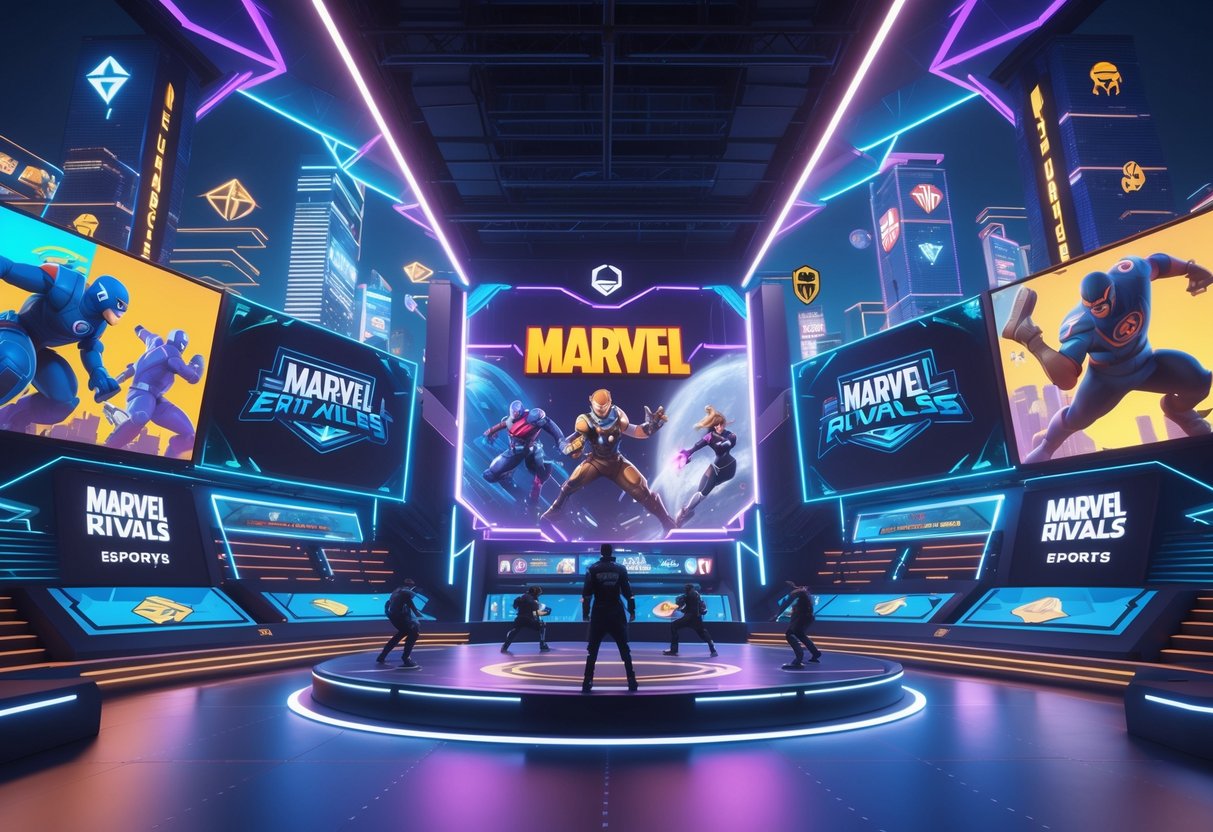
Marvel Rivals is stepping into a competitive shooter world already shaped by giants. Overwatch went from darling to struggling, showing how hard viewer engagement can be. Meanwhile, VALORANT and Counter-Strike show what it takes to build a sustainable scene.
Lessons from Overwatch and Overwatch 2
Overwatch started with massive esports hype but ran into trouble with spectator confusion. The action moved so fast that viewers often lost track during team fights.
What Marvel Rivals can pick up from Overwatch’s stumbles:
- Visual overload – Too much chaos on screen
- Broadcast format issues – Camera switches made things confusing
- Meta stagnation – Not enough strategy variety at the top level
Overwatch 2 tried to fix things by shrinking teams from 6v6 to 5v5, making matches easier to watch but splitting the community.
The franchise model for the Overwatch League cranked up financial pressure. Teams started dropping out when viewership lagged behind expectations.
Marvel Rivals faces some of the same spectator headaches. With lots of heroes and flashy abilities all at once, it’s tough for viewers to keep up. Early tournaments show viewership lagging behind the game’s streaming buzz.
Honestly, hero shooters just have a hard time turning casual viewers into die-hard esports fans.
Impact of VALORANT and Counter-Strike
VALORANT nailed what Overwatch couldn’t by keeping gameplay straightforward. Round-based matches and clear goals make broadcasts much easier to follow.
Counter-Strike’s been around for 20 years, proving the value of consistent rules. The game barely changes, allowing deep strategies to evolve.
VALORANT’s secret sauce:
- Simple round structure – New viewers get it right away
- Strategic options – Multiple ways to play each round
- Co-streaming – Streamers bring their own crowds to tournaments
Both games assign clear roles to players. You can spot the sniper, support, or entry fragger instantly.
Marvel Rivals tournaments already use co-streaming. When creators like Shroud cast matches, they pull their fans into the scene.
But here’s the thing—Marvel Rivals is just more complicated. Counter-Strike and VALORANT focus on shooting and positioning. Marvel Rivals throws in hero powers, ultimates, and nonstop team fights, which can overwhelm spectators.
Professional Player and Organisation Engagement
Big esports orgs quickly noticed Marvel Rivals’ potential. Established teams built rosters while experienced players jumped in from other hero shooters. The mix of traditional giants and creator-backed teams signals real early confidence in the game’s competitive future.
Roster Building in Early Tournaments
Top orgs wasted no time. 100 Thieves, Sentinels, and Virtus.pro led the charge, with OG and Fnatic joining from Europe.
One of the biggest moves came from Shroud. He built a team just for Marvel Rivals, drawing huge attention thanks to his co-streaming.
North American orgs dominate the early investment. Teams like FlyQuest and Envy are building competitive rosters, seeing the region’s viewership as a big opportunity.
What established orgs bring to the table:
- Infrastructure for player support
- Marketing muscle to promote events
- Financial stability for consistent play
- Experience running top-level teams
Marvel Rivals Invitational tournaments already showcase these pro squads. The prize pools are modest—£14,500 per region—but they give new teams valuable experience.
Transition of Talent from Other Titles
Pros from Overwatch and other hero shooters are starting to check out Marvel Rivals. The familiar mechanics make it pretty easy for seasoned FPS players to jump in.
Noticed trends:
- Ex-Overwatch pros testing new team setups
- Valorant players using their aim on new heroes
- Content creators building teams around themselves
The talent migration isn’t huge yet. Most pros still focus on their main games and just test Marvel Rivals on the side.
Shroud’s team stands out for its strategy—building around a streaming brand. It’s a smart way to bridge casual viewers with serious competition.
Regional differences shape these moves. North American players show more interest than Europeans, probably because their tournaments pull bigger numbers.
The scene could use a few more high-profile player signings to really boost viewership. Right now, teams mix up-and-comers with established names, which does make for some interesting stories.
Game Monetisation and Player Accessibility
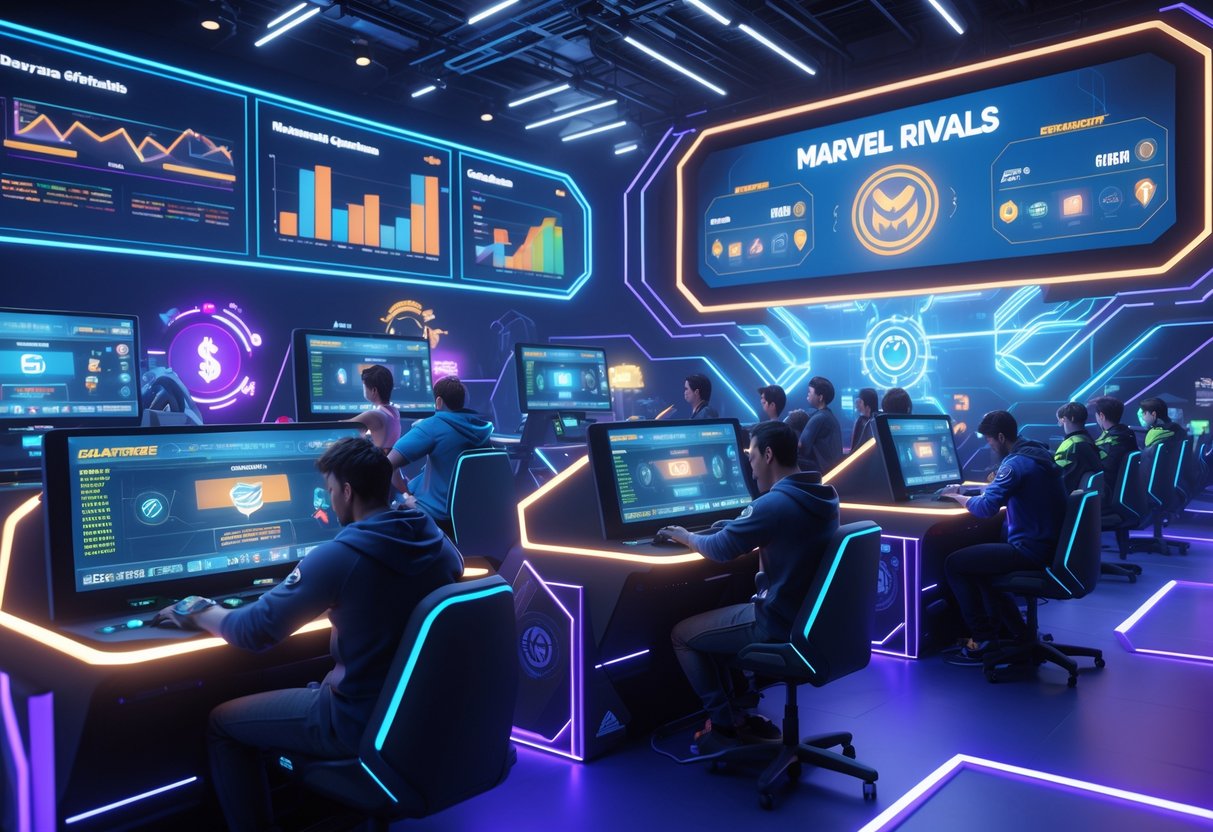
Marvel Rivals runs on a free-to-play model with cosmetic monetisation, keeping things open to players at every skill level. The system removes financial barriers for competition and brings in revenue through optional skins and upgrades.
Free-to-Play Model
Marvel Rivals launched totally free on PC, Xbox, and PlayStation. Players get the whole hero roster right away—no payment needed.
No Pay-to-Win There are no character unlocks or gameplay boosts behind paywalls. Every hero and ability is open to everyone from the start.
This matters a lot for esports. Teams can recruit based on skill, not who can afford premium content. New players aren’t locked out of ranked games by money.
Cosmetics Only NetEase makes money only from optional cosmetic buys. Players pick up skins, poses, and effects that don’t mess with balance.
It’s a familiar model—think Valorant or Counter-Strike. Teams and sponsors can focus on talent, not unlock costs.
Cosmetic Rewards and Incentives
Cosmetics come as both paid items and rewards for playing. Players unlock basic skins by completing challenges and seasonal goals.
Team Bundles Dev teams confirmed they’ll offer team-branded bundles with profits split to help pros and prize pools. This links fan spending directly to the esports ecosystem.
Early testing tried Twitch Drops during the Marvel Rivals Ignite Mid-Season Finals. Viewers could earn exclusive skins just by watching, tying esports viewership to in-game rewards.
Accessibility With cosmetics-only monetisation, skilled players from any background can compete at the top. College teams and amateur leagues benefit from having no entry costs.
Heads up: the game’s free, but if you want lots of cosmetics, those microtransactions add up fast.
Spectator Experience and Broadcast Features
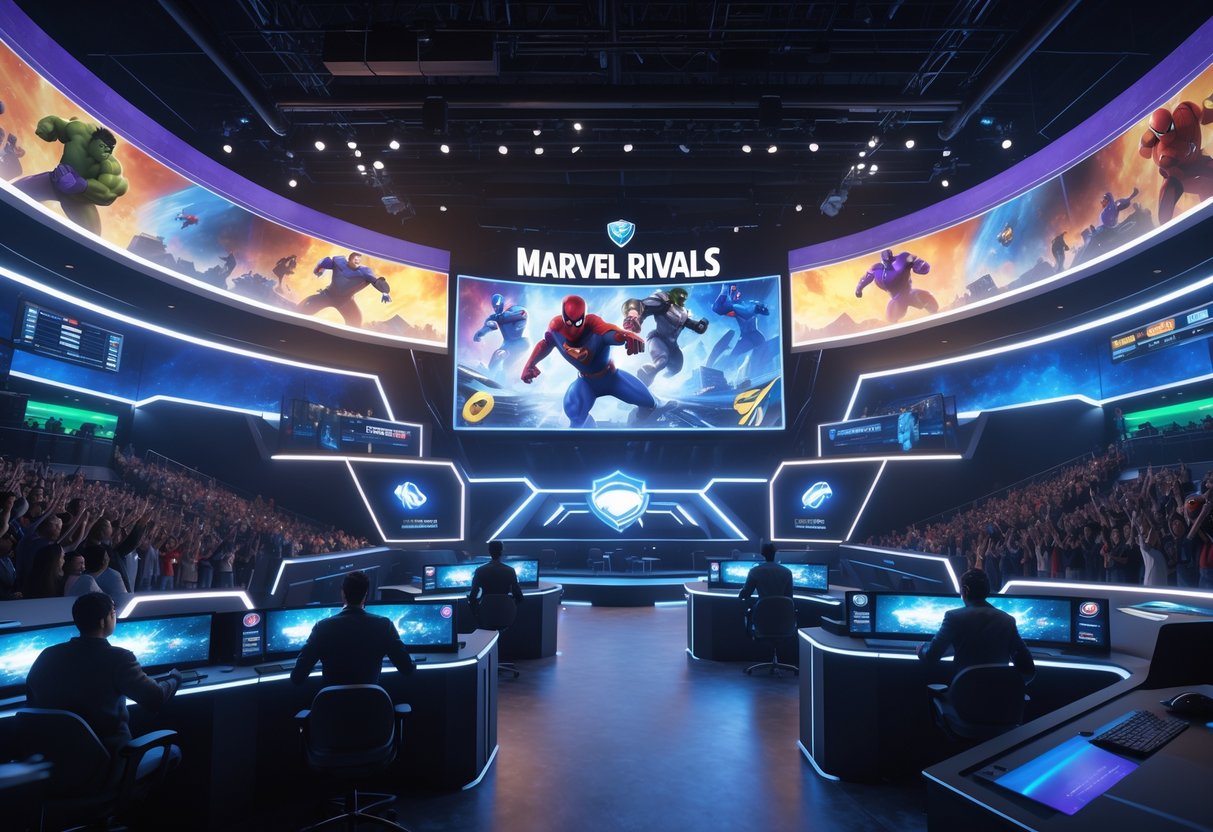
Marvel Rivals faces the usual hero shooter problem: how do you make chaotic team fights watchable? The current spectator tools show some promise, but they’re not quite up to par with Counter-Strike or League of Legends yet.
Spectator Modes and Viewer Experience
Marvel Rivals includes basic spectator features through its replay and observer modes. Players can swap between camera angles—first-person, overhead, whatever works.
Visual clarity is a big deal during team fights. With 12 heroes throwing out abilities, viewers easily lose the plot. The devs try to help with outlines and ability indicators, but honestly, it still needs work.
What’s available:
- Free camera
- Player POV switching
- Kill feed
- Ultimate timers
- Mini-map overlay
Tournament streams show mixed viewer engagement. The Marvel Rivals Invitational topped out around 23,000 on official channels. Co-streams with big creators like Shroud gave those numbers a real boost.
Observers have a tough job. Destructible maps and multi-level layouts make it hard to catch everything onscreen. Sometimes, key plays just happen off camera.
Streaming and Content Creation
Content creators seem to love Marvel Rivals, maybe even more than hardcore esports fans do. The game sits comfortably in Twitch’s top 10 for active streamers, even beating out Counter-Strike on some days.
Popular formats:
- Ranked ladder grinds
- Hero guides
- Team comp breakdowns
- Pro match analysis
The Marvel brand definitely helps pull in creators. Streamers like TimTheTatman, xQc, and Ninja regularly play Marvel Rivals, bringing their huge audiences into the mix.
Co-streaming is probably the biggest growth lever for Marvel Rivals esports. When top streamers commentate tournaments, viewership spikes. Valorant already proved this works.
Streaming just fits Marvel Rivals better than traditional broadcasts. Individual streamers can focus on a single hero or angle, making the chaos easier to follow. This helps bridge casual fans and competitive events.
Heads up: the current broadcast tools still limit pro production quality compared to the bigger, older esports games.
Challenges and Areas for Improvement
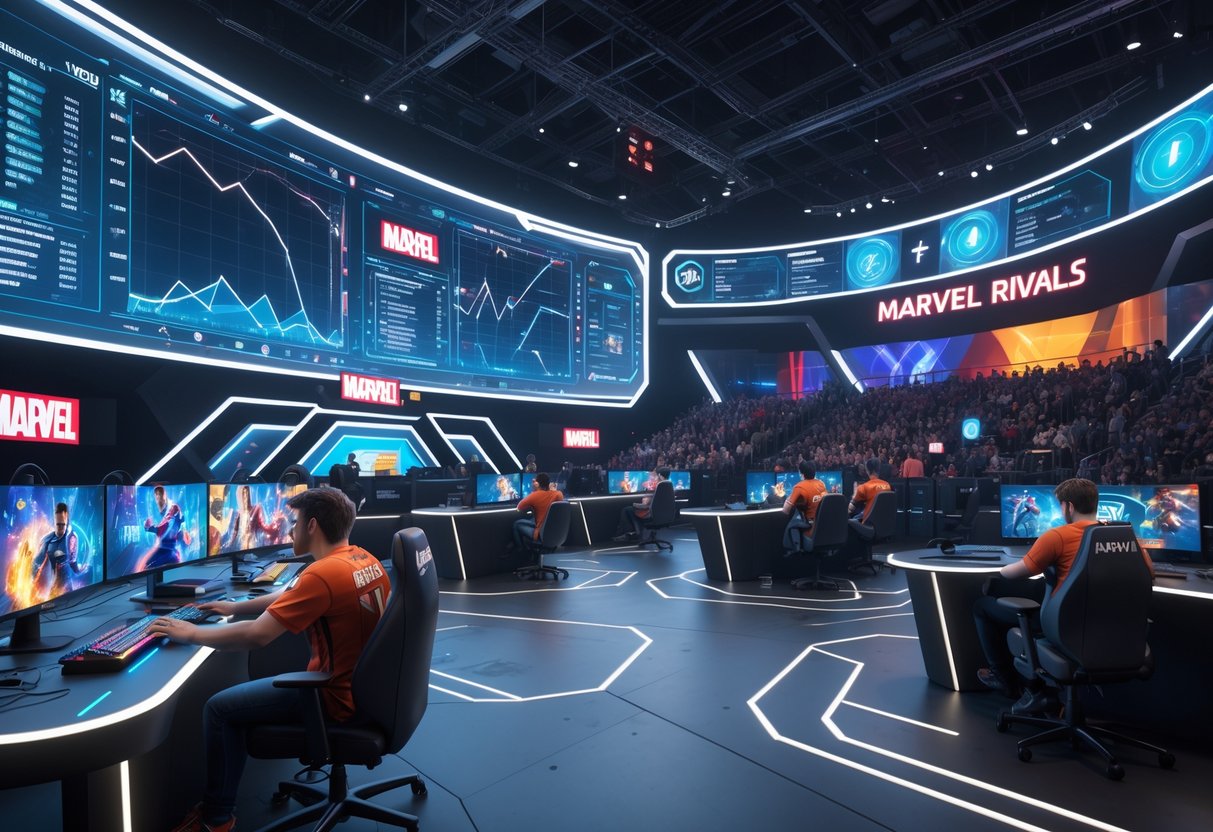
Marvel Rivals runs into some big hurdles with balancing gameplay mechanics and building real community support. The game’s complicated systems and the way matches get shown can make it tough for the competitive scene to really take off.
Balancing and Meta Concerns
The competitive scene constantly wrestles with Marvel Rivals’ character-switching system during matches. Plenty of players argue that hero shooters really need structured pick/ban systems if they want to work well in esports tournaments.
Key balancing issues:
- Players can swap characters mid-match, which throws off strategic planning.
- Fast-paced gameplay often leaves spectators confused.
- Abilities interact in ways that can make matches tough to follow on stream.
Viewers keep pointing out that first-person perspectives work great for highlight reels but not so much for live tournament coverage. That’s a big problem if the game wants to build a steady audience.
Pro teams and analysts worry about the meta staying stable. If there aren’t clear character restrictions, matches sometimes just devolve into chaos. The scene really needs rules that make sense to both players and viewers.
Community Feedback and Longevity
Community support, honestly, matters more for esports success than anything the developer can throw at it. Marvel Rivals gets a mixed bag of reactions from its players when it comes to competitive potential.
The main concerns:
- People wonder if the game even needs to be an esport.
- Some doubt it’ll stick around as long as the big titles.
- Players question how committed NetEase actually is to fostering competition.
Forum threads are full of skepticism about where the game is heading. A lot of folks just like Marvel Rivals for casual fun, but they’re not sure it has the depth for a serious competitive scene. There’s this ongoing debate—does every game really need pro tournaments?
The community can’t agree on the best way to present matches or run tournaments. Many want simpler formats that new viewers can actually follow. Without strong grassroots support, professional leagues just can’t hold onto an audience for long.
Early tournament viewership looks promising, but the game needs to address these basic community worries if it wants to keep growing.
Future Outlook for Marvel Rivals Esports
NetEase says they’ve got a 10-year plan for Marvel Rivals, with esports as a big part of that vision. Their heavy investment in both development and marketing makes it pretty clear they’re aiming for long-term competitive growth well past 2025.
Upcoming Esports Plans
NetEase talked about their esports intentions at the Q4 2024 earnings call, but they’re still keeping most details quiet. They did confirm they’re working on a full esports plan to “further enhance the gaming ecosystem.”
What we know so far:
- They’ll announce official tournament structures soon.
- An international competition framework is in the works.
- They want to tie esports into the game’s seasonal updates.
NetEase launched their first international tournament less than a year after Marvel Rivals dropped in December 2024. That quick rollout shows they’re serious about making Marvel Rivals a competitive powerhouse.
Big names like OG, Fnatic, and 100 Thieves have already picked up Marvel Rivals teams. That early buy-in hints at some real industry confidence.
NetEase’s 10-year commitment gives the scene some stability—something a lot of other esports titles just don’t have. This long-term focus should help players and organisations feel a bit more secure about investing in Marvel Rivals esports.
Potential for Global Expansion
Marvel Rivals has already pulled in over 40 million players worldwide. That’s a massive potential audience for competitive play.
The game’s global reach covers a bunch of regions, and teams in North America and Oceania are already competing.
Regional organisations are building rosters across different territories. FURY Esports has an Oceania squad, while FlyQuest handles North America.
Signs of expansion:
- Teams investing across multiple regions.
- International tournament plans in motion.
- Local competitive scenes starting to pop up.
Hero shooters have done well globally—just look at Overwatch and its regional leagues. Marvel Rivals’ connection to the Marvel universe gives it a leg up in places where superheroes are a big deal.
Cross-media promos could speed up global growth. NetEase said they’re planning “crossover events and promotions with other media,” so maybe that’ll pull in Marvel fans who haven’t tried esports yet.
Frequently Asked Questions
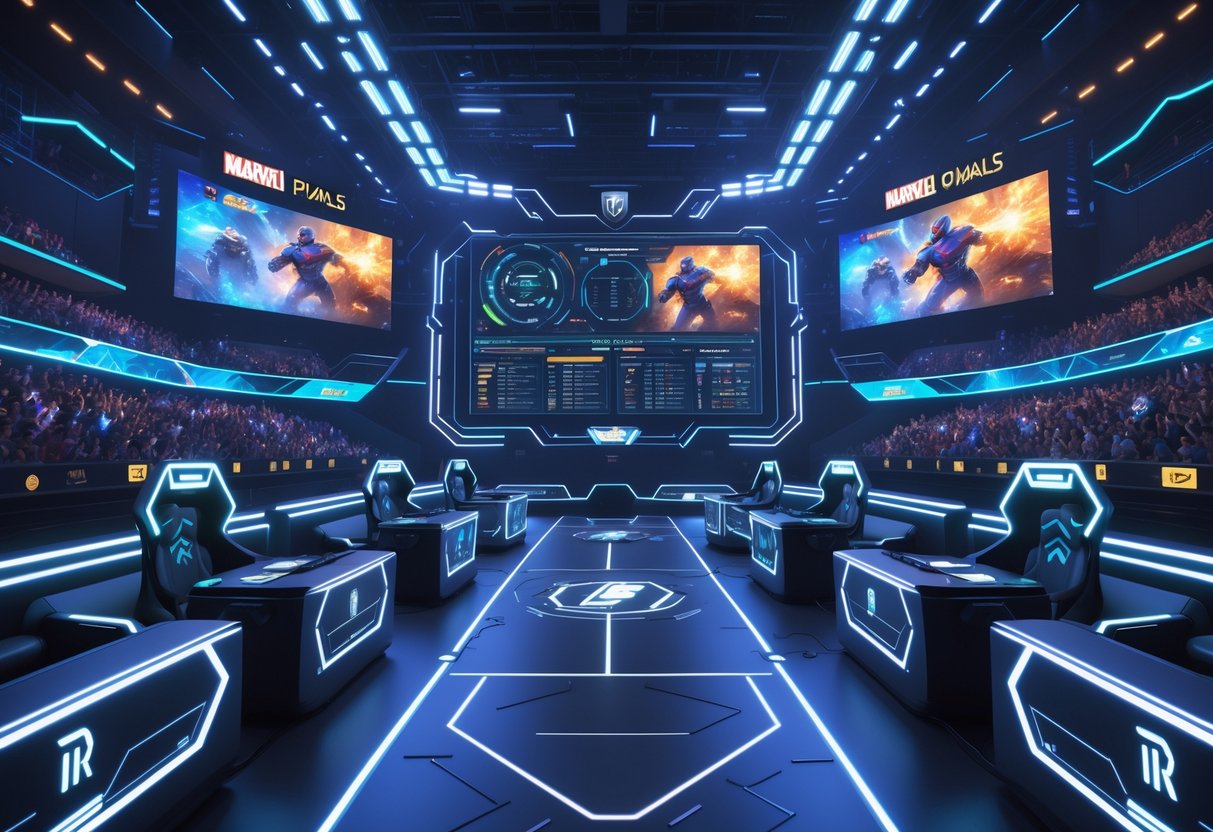
The Marvel Rivals competitive scene is picking up steam, which means players and fans have a lot of questions about team strategies, how to go pro, and where to get involved. Major organisations are jumping in, and players are looking for clear ways into the competitive world.
What team compositions are dominating the Marvel Rivals esports scene currently?
Tank-heavy comps with multiple frontline heroes are running the show in pro matches. Most teams stick with two tanks, two damage dealers, and two supports.
Winning teams focus on hero synergies, not just individual picks. Pairing tanks who can create space together, while support heroes keep them alive, is a common approach.
Teams that can switch roles mid-match and stay flexible usually come out on top. Sticking to one rigid setup just doesn’t cut it anymore.
How can one get involved with competitive Marvel Rivals at a collegiate level?
University esports clubs are quickly adding Marvel Rivals to their lineups. If you’re interested, check out your local university’s gaming society or esports club for tryouts and practice sessions.
A lot of colleges are putting together teams for upcoming collegiate tournaments. The British University Esports Association (BUEA) looks set to include Marvel Rivals in future events.
Start by joining university Discord servers where competitive gaming happens. Practice with other students and play in internal tournaments to get some experience before trying out for official teams.
Where can fans and players discuss the latest trends and events in Marvel Rivals esports?
Reddit’s Marvel Rivals competitive communities are buzzing with daily discussions about pro matches and strategy. The main subreddit has post-match breakdowns and tournament schedules.
Discord servers for top esports orgs offer live chat during tournaments. Twitter and Twitch chat are still the go-to for following events in real time.
Gaming forums host longer, more detailed talks about team moves and meta shifts. A lot of pro players also share tips and news on their social media.
Who are some of the top professional players in the Marvel Rivals competitive community?
100 Thieves crushed the North American Invitational, going undefeated the whole way. Their roster features players who made the jump from other hero shooters.
Sentinels, FlyQuest, and Envy have picked up strong rosters with talent from games like Overwatch and Valorant. Many of the top players bring experience from those scenes.
Europe’s scene is growing fast, with orgs like Fnatic and OG building impressive lineups. Player transfers between regions are starting to happen more as things heat up.
What impact has the downtime in Marvel Rivals competitive servers had on the esports landscape?
Server issues have messed with some smaller tournaments and team practice schedules. Pro teams now plan around maintenance windows and updates.
Tournament organisers add buffer time to their schedules to handle tech hiccups. This means event formats are a bit more flexible to deal with delays.
NetEase keeps rolling out updates to fix competitive play issues. Their long-term support should mean better stability for big events in the future.
How is the expansion of esports organisations like Moist Esports influencing Marvel Rivals tournaments?
Big esports organisations are stepping in and bringing their professional know-how to Marvel Rivals events. You can see it in the improved production quality and, honestly, the prize pools just keep getting bigger.
These organisations give players access to coaching, analysts, and support staff—stuff that wasn’t really around before. That kind of backing pushes the skill level higher and makes matches feel way more professional.
When well-known brands invest, sponsors and media outlets start to pay attention. Now we’re seeing more structured leagues and a steady stream of competitions popping up all the time.

